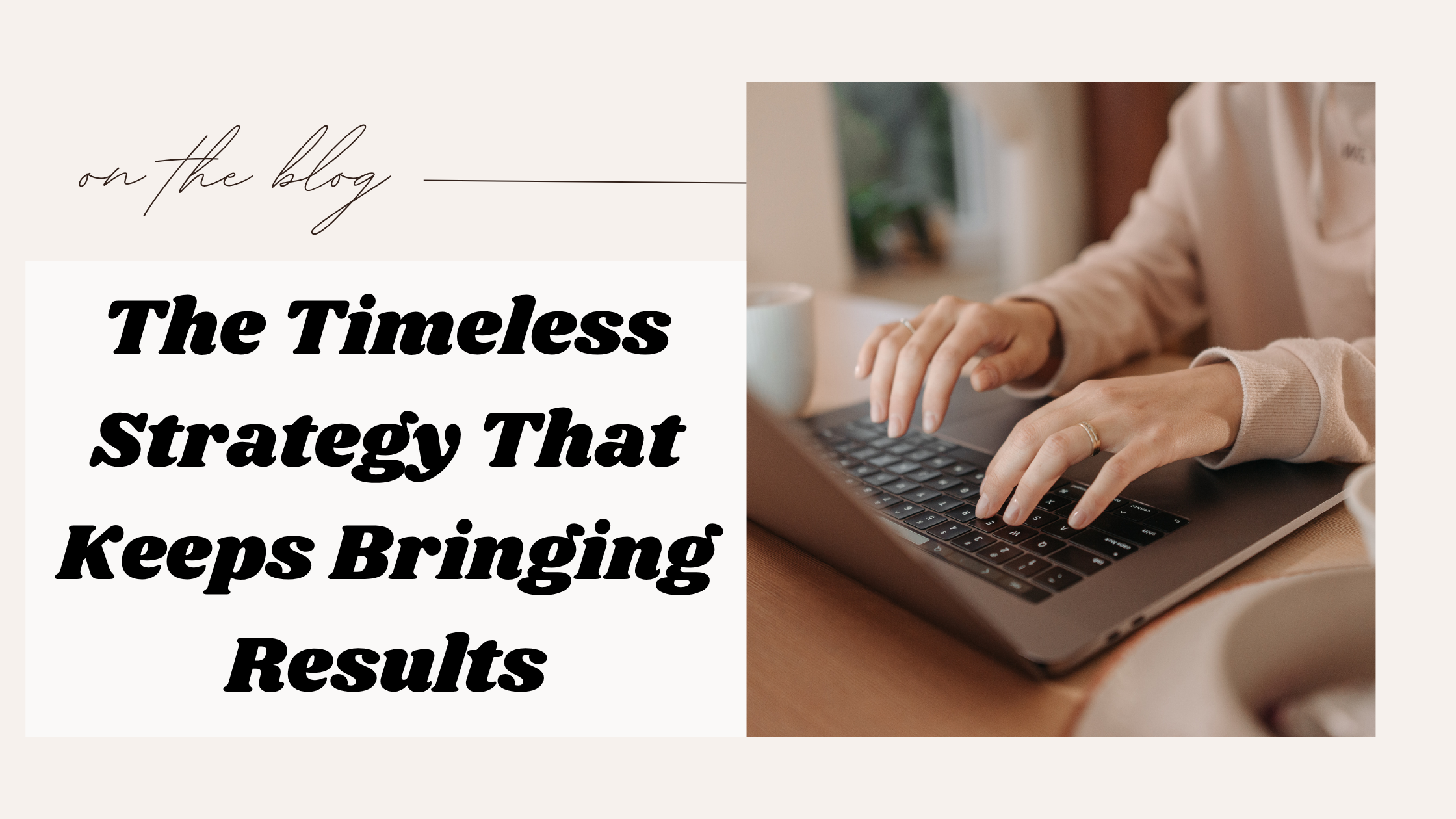In an era of ever-changing algorithms, viral gimmicks, and AI-generated content floods, a quiet revolution continues to win — one that’s not breaking news but consistently delivering value. While many chase digital trends that fade faster than they arrive, some brands are playing the long game — and winning big.
This isn’t about jumping on the latest platform or reverse-engineering Google’s algorithm updates. It’s about anchoring your business in a strategy that survives the chaos — and thrives because of it.
So, what’s this so-called timeless strategy? And why does it still work in 2025, when the digital landscape feels anything but predictable? Let’s dissect the myths, explore the mechanics, and uncover the power behind the playbook that refuses to get old.
The Myth of the Next Big Thing
The Digital World’s Obsession with Trends
Constant chasing of new tools, hacks, and tactics
The internet is a breeding ground for “game-changing” tools and viral marketing hacks. From AI copywriting bots to TikTok growth formulas, digital marketers often find themselves chasing the next miracle cure. The problem? Most of these tools are fleeting fixes — not long-term solutions.
New platforms rise, old ones fade, and the so-called hacks lose potency once everyone starts using them. The pursuit of novelty feels urgent, but it leads many businesses into a hamster wheel of experiments with little to show for it.
Burnout from trying every shiny new thing
For many businesses, this cycle leads to marketing fatigue. Teams burn out implementing new tactics every quarter, with minimal return. Attention is scattered, messaging diluted. Instead of building something sustainable, the strategy becomes a series of disconnected stunts — each promising more than it delivers.
The Cost of Abandoning Proven Strategies
Real examples of brands that lost momentum by ditching the fundamentals
Remember Clubhouse? Or the brands that pivoted all their resources to Facebook Watch? When brands divert focus from foundational SEO, content, and user value — just to follow a trend — they risk becoming casualties of digital whiplash.
One prominent e-commerce brand doubled down on influencer marketing in 2022, abandoning its evergreen blog strategy. Their organic traffic plummeted. Why? Because when the influencer buzz dried up, they had no content ecosystem to fall back on.
The “fad fatigue” effect on ROI
The obsession with being first can actually erode ROI. Launching campaigns based on hype means constantly testing, rebuilding, and correcting. It’s expensive — not just financially but in brand equity. Consumers don’t want to be guinea pigs. They want reliability. And they notice when your message constantly changes with the wind.
The Timeless Strategy Unveiled
Organic, Value-Driven Visibility
Explanation: Consistent, value-rich content paired with ethical SEO
The strategy that keeps delivering isn’t complicated — it’s just not glamorous. It’s about showing up, consistently, with content your audience actually wants. It’s pairing that content with SEO practices rooted in ethics, not shortcuts. Think of it as relationship-building at scale — not tricking search engines, but serving humans.
Why this strategy doesn’t get old
Algorithms evolve to mimic user behavior. So if your strategy is aligned with helping users — by answering questions, solving problems, offering insights — then no update can make it obsolete. It remains relevant because people remain at its center.
Supported by: Trust, relevance, and long-term ranking power
Google rewards relevance, expertise, and clarity. And users reward brands that feel familiar, useful, and trustworthy. This is a strategy built on trust — and trust compounds over time. Unlike traffic spikes from ads or social media trends, this growth doesn’t vanish overnight.
Why It Works Across Industries and Eras
Not platform-dependent
Whether your audience is on Instagram or LinkedIn, TikTok or email — they still search. They still ask questions. And they still find you through content that solves a problem or shares knowledge. That’s platform-agnostic power.
Not algorithm-sensitive (but algorithm-aligned)
Search engines reward what humans value. So if your content offers clear answers, is technically sound, and is built for real people — you’re already aligned. You’re not gaming the algorithm; you’re respecting it.
Builds brand equity, not just traffic
While paid ads chase attention, organic visibility builds identity. Your brand becomes associated with knowledge, not just noise. Over time, your domain becomes a trusted source — not just a website with content, but a voice worth listening to.
Real-World Success Stories
Case Study 1: A Small Brand That Grew Big with Consistency
How long-term content and SEO turned a local brand global
An Oxford-based eco-friendly home goods brand began with a simple blog answering questions about sustainable living. They didn’t advertise. They didn’t chase trends. But their content kept appearing on search results month after month.
Three years later, those blog pages rank globally. The content hasn’t been replaced — just updated. That same content brings in leads, press mentions, and brand partnerships. Consistency, not virality, built their momentum.
Case Study 2: Big Brand Loyalty Without Paid Ads
A brand that relied solely on audience trust and long-term visibility
A financial education platform scaled its traffic 800% in 24 months — with zero ad spend. They focused on publishing 3 deeply researched articles a week. Over time, they became the go-to source for financial literacy among Gen Z and millennials.
What fueled their growth? Value-first content, high-authority backlinks, and content designed to genuinely help users. No clickbait, no gimmicks — just strategy with substance.
Core Components of the Strategy
Customer-Centric Content
Content designed to serve, not sell
This strategy starts with empathy. Great content answers the reader’s “what’s in it for me?” — clearly and generously. Whether it’s a tutorial, insight, or checklist, the goal isn’t to convert immediately. It’s to connect. Sales come later, naturally.
Ethical SEO Fundamentals
Technical, on-page, and off-page elements that are algorithm-proof
Instead of keyword stuffing or shady backlinks, ethical SEO means:
- Clean, crawlable site structure
- Relevant keywords mapped to intent
- Authoritative internal and external linking
- Schema markup for rich results
- Mobile-first, fast-loading pages
These aren’t hacks — they’re hygiene. And they’ve never gone out of style.
Patience and Consistency
The compound effect of doing it right — repeatedly
No one wins the SEO game in a week. But brands that keep showing up with quality content every month? They start to own their space. Organic SEO isn’t fast, but it’s exponential. Once it clicks, it builds on itself — and your competitors will struggle to catch up.
Why This Strategy Still Works in 2025 (and Beyond)
Alignment with Google’s Helpful Content Updates
Google’s recent updates prioritize content that’s people-first. This shift means recycled, robotic, or AI-only content won’t cut it. The timeless strategy works because it aligns perfectly with this shift — helping humans first, and optimizing second.
Rising user fatigue with hard-sell tactics
Audiences are more discerning. Pop-ups, aggressive CTAs, and manipulative funnels don’t impress anymore. People crave authenticity. They want answers, not ads. That’s why content that teaches, guides, and informs continues to win.
Growing preference for authentic, helpful brands
Brand loyalty today is built on perceived honesty. If your website feels like a helpful friend — not a billboard — users stay, engage, and return. That’s not a fad. That’s psychology.
Common Mistakes That Kill Long-Term Strategies
Inconsistency
Publishing five blogs one month, then going silent for three? That breaks trust — with your audience and search engines. Consistency signals authority. It’s not about flooding content; it’s about showing up reliably.
Keyword stuffing or clickbait tactics
These tactics might bring temporary clicks, but they kill credibility. And they trigger algorithm penalties. Prioritize clarity and intent over manipulation.
Prioritizing speed over sustainability
A viral campaign might feel exciting, but does it bring lasting ROI? Brands that sprint often stall. The ones that build slow — but smart — keep running long after the trendsetters disappear.
How to Start (or Restart) This Timeless Strategy Today
Audit your current online presence
Start by analyzing what’s working — and what’s not. Which pages bring organic traffic? Which topics your audience loves? Which areas are outdated or thin? Tools like Google Search Console and Ahrefs can guide your audit.
Set up a content calendar
Consistency needs structure. Plan 2–4 high-quality pieces each month, focused on user intent. Blend how-tos, insights, comparisons, and stories. Think like an educator, not a salesperson.
Rebuild your foundation with intention
Update your site architecture. Fix technical SEO issues. Improve internal linking. Add schema where relevant. Make sure every piece of content has a clear purpose and supports your brand’s authority.
Conclusion: Results That Outlast Algorithms
Why slow, steady, and strategic still wins the race
The digital landscape will keep shifting. New tools will emerge. Shortcuts will be sold. But none of them replace the trust you build through consistent, ethical, and valuable content.
Final thought: “In a world chasing trends, consistency is your unfair advantage”
This strategy may not trend on LinkedIn, but it will quietly outperform the noise. And if you’re looking for help executing it, you might consider partnering with an experienced organic SEO agency that understands the long game.
FAQs
1. Why should I invest in organic SEO instead of just running paid ads?
Paid ads give you instant visibility but vanish the moment you stop spending. Organic SEO builds long-term visibility, credibility, and trust. It compounds over time, lowering your cost per lead and increasing brand equity.
2. How long does it take to see results from this timeless SEO strategy?
Typically, it takes 3 to 6 months to start seeing traction, and 12+ months to see significant ROI. SEO is a long-term investment — but its returns last far longer than paid campaigns.
3. What kind of businesses benefit most from organic SEO?
Any business that relies on online visibility — from local service providers to global SaaS companies — can benefit. It’s especially powerful for businesses with educational or expertise-driven content.
4. Is blogging still relevant for SEO in 2025?
Absolutely. Blogging, when done right, drives organic traffic, supports internal linking, and builds topical authority. It’s still one of the most effective ways to show expertise and engage audiences.
5. Can AI-generated content be part of a timeless strategy?
AI can assist with drafts and research, but it should never replace human insight. Authentic, useful, and empathetic content still requires human touch — especially for building trust with readers and ranking sustainably.





